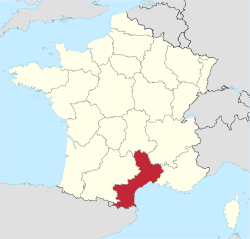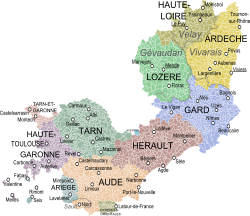Languedoc-Roussillon
Languedoc-Roussillon (Occitan: [Lengadòc-Rosselhon] Error: {{Lang}}: text has italic markup (help); Catalan: [Llenguadoc-Rosselló] Error: {{Lang}}: text has italic markup (help)) is a former administrative region of France. It is now part of the administrative region of Occitanie. It is the southernmost region of mainland France and borders to the south with Spain and Andorra.
|
Lengadòc-Rosselhon (Occitan) | |
|---|---|
 | |
| Country | |
| Dissolved | 2016-01-01 |
| Prefecture | Montpellier |
| Departments | 5
|
| Government | |
| • President | Damien Alary (DVG) |
| Area | |
| • Total | 27,376 km2 (10,570 sq mi) |
| Population (2012-01-01) | |
| • Total | 2,700,266 |
| • Density | 98.6363/km2 (255.467/sq mi) |
| Time zone | UTC+1 (CET) |
| • Summer (DST) | UTC+2 (CEST) |
| ISO 3166 code | FR-K |
| GDP (2012)[1] | Ranked 10th |
| Total | €63.9 billion (US$82.2 bn) |
| Per capita | €23,566 (US$30,311) |
| NUTS Region | FR8 |
| Website | laregion.fr |
The five departments in the region were Aude, Gard, Hérault, Lozère, and Pyrénées-Orientales.
Its capital was Montpellier, the largest city. In French, the name of the inhabitants of the region is Languedocien-Roussillonnais.
Etymology
The name of the province of Languedoc originates from the language spoken in southern France, langue d'oc, also known as Occitan, and Roussillon, an area in the South of present-day Languedoc-Roussillon.
Geography
The Languedoc-Roussillon region has an area of 27,376 km2 (10,570 sq mi). It bordered to the south with Spain and Andorra; to the east is the Mediterranean Sea (the Gulf of Lion). It also bordered four French regions: Midi-Pyrénées to the west, Auvergne and Rhône-Alpes to the north, and Provence-Alpes-Côte d'Azur (PACA) to the northeast.
The highest point in Languedoc-Roussillon is Pic Carlit (42°34′11″N 01°55′55″E / 42.56972°N 1.93194°E) in the Pyrénées-Orientales department; it is 2,921 m (9,583 ft) high.[2]
Departments
The Languedoc-Roussillon region is formed by five departments:
| Département | Préfecture | ISO 3166-2 |
Population (2012)[3] |
Area (km²) |
Density (Inh./km²) |
|---|---|---|---|---|---|
| Aude | Carcassonne | FR-11 | 362,339 | 6,139 | 59.0 |
| Gard | Nîmes | FR-30 | 725,618 | 5,853 | 124.0 |
| Hérault | Montpellier | FR-34 | 1,077,627 | 6,101 | 176.6 |
| Lozère | Mende | FR-48 | 76,889 | 5,167 | 14.9 |
| Pyrénées-Orientales | Perpignan | FR-66 | 457,793 | 4,116 | 111.2 |
Demographics
The Languedoc-Roussillon region has a population, in 2012, of 2,700,266,[4] for a population density of 98.6 inhabitants/km2.
The 10 most important cities in the region are:
| City | Population (2012)[3] |
Départment |
|---|---|---|
| Montpellier | 268456 | Hérault |
| Nîmes | 146,709 | Gard |
| Perpignan | 120,489 | Pyrénées-Orientales |
| Béziers | 72,970 | Hérault |
| Narbonne | 51,869 | Aude |
| Carcassonne | 47,068 | Aude |
| Sète | 44,558 | Hérault |
| Alès | 41,031 | Gard |
| Lunel | 25,405 | Hérault |
| Agde | 24,651 | Hérault |
Gallery
Languedoc-Roussillon Media
Landscape in Lozère, Languedoc-Roussillon
Landscape in Aude, Languedoc-Roussillon
Pont du Gard aqueduct near Nîmes
References
- ↑ INSEE. "Produits intérieurs bruts régionaux et valeurs ajoutées régionales de 1990 à 2012". Retrieved 2014-03-04.
- ↑ "Le reliefs des Pyrénées-Orientales" (in French). A la découverte des Pyrénées Catalanes. Retrieved 15 June 2015.
{{cite web}}: CS1 maint: unrecognized language (link) - ↑ 3.0 3.1 "Populations légales 2012 des départements et des collectivités d'outre-mer" (in French). Institut national de la statistique et des études économiques - INSEE. Retrieved 17 June 2015.
{{cite web}}: CS1 maint: unrecognized language (link) - ↑ "Populations légales 2012 des régions" (in French). Institut national de la statistique et des études économiques - INSEE. Retrieved 15 June 2015.
{{cite web}}: CS1 maint: unrecognized language (link)
Other websites
| Wikimedia Commons has media related to Lua error in Module:Commons_link at line 62: attempt to index field 'wikibase' (a nil value).. |












